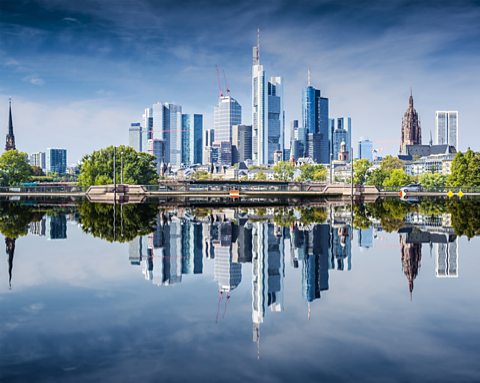Describing towns or villages
Beschreib deine Stadt.– Describe your town.
Beschreib dein Dorf.– Describe your village.
Using the accusative
You can use the word hat from haben (to have) with the accusative case to say what your town or village 'has' to offer:
Meine Stadt hat...
- ...siebzig Tausend Einwohner – seventy thousand inhabitants
- ...eine Fußgängerzone – a pedestrian precinct
- ...einen Bahnhof/Busbahnhof – a train station/bus station
- ...gute öffentliche Verkehrsmittel – good public transport
- ...eine schöne Altstadt – a lovely old part of town
- ...ein Stadion – a sports stadium
- ...ein Fitnesszentrum – a leisure centre
Using 'es gibt'
You can also use es gibt (there is/there are), but the noun that follows this phrase always has to be in the accusative case.
In meiner Stadt/in meinem Dorf gibt es...
...einen Spielpatz– a playground/park
...viele Sport- und Kulturmöglichkeiten – a lot of facilities for sport and culture
...(nicht) viel für Jugendliche– (not) much for young people
...(nicht) viel zu tun– (not) a lot to do
...viele alte Häuser– lots of old buildings/houses
...viele Hochhäuser– a lot of skyscrapers, tower blocks
...Geschäfte und Kaufhäuser– a lot of shops and department stores
...(nicht) viel Verkehr– (not) a lot of traffic
...Lärm von den Autos– noise from the cars
...viele Menschen– a lot of people
...(nicht) viel Verschmutzung– (not) a lot of pollution
Question
Beschreib deine Stadt
Using full sentences with conjunctions and intensifierA word that adds intensity to another adjective, adverb or verb, eg 'very'. Intensifiers often have little meaning when used on their own., eg sehr, und, auch, aber, leider, weil, how would you describe your town if it had the following?
Meine Stadt hat...
- 80,000 inhabitants
- not much for young people
- a pedestrian zone
- not a lot of traffic
- a good public transport system
- good shopping
- a pretty old part of town
Meine Stadt hat achtzigtausend Einwohner, aber leider gibt es nicht viel für Jugendliche. Sie hat eine Fußgängerzone und es gibt nicht viel Verkehr, weil es gute öffentliche Verkehrsmittel gibt. Es gibt viele Geschäfte und Kaufhäuser, aber auch eine schöne Altstadt.
Using 'man kann'
To say what you can see or do in the area you live in, you just need to use the phrase man kann (you can/one can) and an infinitiveThe part of the verb found in the dictionary. It is the basic form of a verb without a subject, and the equivalent of English 'to...' verbs, and usually ends in -en, -n, -ern, -eln in German, eg spielen - to play..
Was kann man in deiner Stadt oder Gegend sehen oder tun?– What can you see or do in your town or area?
Question
What do these phrases mean?
- man kann im Freibad schwimmen gehen
- man kann in der Kunsthalle tolle Bilder sehen
- man kann nicht ins Theater gehen
- man kann im Einkaufszentrum oder in der Fußgängerzone shoppen gehen
- man kann über die Felder reiten
- man kann im Fitnesszentrum Sport machen
- man kann im Freibad schwimmen gehen - you can go swimming in the outdoor pool
- man kann in der Kunsthalle tolle Bilder sehen - you can see nice pictures in the art gallery
- man kann nicht ins Theater gehen - you can't go to the theatre
- man kann im Einkaufszentrum oder in der Fußgängerzone shoppen gehen – you can go shopping in the shopping centre or pedestrian zone
- man kann über die Felder reiten – you can ride through the fields
- man kann im Fitnesszentrum Sport machen – you can do sport in the gym
Question
How would you say the following in German? Don't forget to use conjunctions or to make any necessary changes to word order.
- In my town there is a lot to do.
- You can't go to the theatre because there is no theatre.
- You can go riding.
- You can see nice pictures because there is an art gallery.
- You can go shopping because there are both a lot of shops and also pedestrian zone.
In meiner Stadt gibt es viel zu tun.
Man kann nicht ins Theater gehen, weil es kein Theater gibt.
Man kann reiten.
Man kann tolle Bilder sehen, weil es eine Kunsthalle gibt.
Man kann shoppen gehen, weil es sowohl viele Geschäfte, als auch eine Fußgängerzone gibt.
Did you know?
Frankfurt am Main (Frankfurt on the River Main) was badly damaged during World War Two. The city had to be rebuilt, including the so-called Altstadt (old part of town) where the new buildings were made to look like the ones that used to be there. So don't be fooled – they're not as old as they look.
For centuries, the Frankfurter Dom (cathedral) was the city's tallest building until the boom of the Frankfurt financial district with its numerous tower blocks and skyscrapers – Hochhäuser und Wolkenkratzer (literally: high houses and cloud scratchers). It is one of the most important financial districts in the world.
Germans often refer to Frankfurt's financial district as 'Mainhattan' – a combination of the Main river and Manhattan
